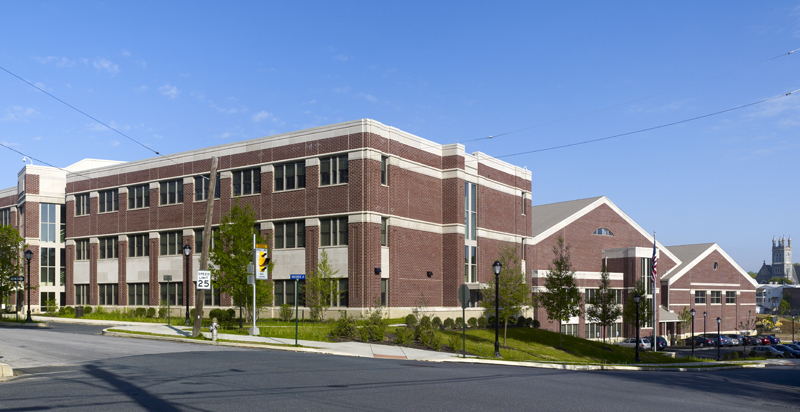Blackney Hayes Architects has announced that Radnor Middle School in Wayne, Delaware County, PA has been named a 2012 National Green Ribbon School by the U.S. Department of Education. One of four schools in the Commonwealth to receive this honor, it is also one of only 78 nationwide. Designed by Blackney Hayes, Radnor earned a LEED Silver rating from the USGBC in 2011.
According to the U.S. Department of Education, the Green Ribbon Schools were selected for programs that “save energy, reduce costs, feature environmentally sustainable learning spaces, protect health, foster wellness, and offer environmental education to boost academic achievement and community engagement.”
At 195,000 sf on a 10-acre site, Radnor Middle School features the latest technologies developed for lowering energy and operating costs, including green roofs, daylighting for classroom spaces, geothermal heating and cooling, high recycled content in building materials, and safe, atmosphere-friendly finishes. On the lobby floor, the school district logo is inlaid with terrazzo tile, recycled glass bottles and mirrors, while nearby a Green Touchscreen explains the sustainable features and systems in an interactive format.
In addition to Blackney Hayes Architects, the design and construction team includes Pennoni Associates, Structural Engineer; Concord Engineering Group, MEP Engineer; Gilmore & Associates, Civil Engineer; Cahill Associates, Stormwater Consultant; Metropolitan Acoustics, Acoustical Consultant; Schuler Shook, Theater Consultant; Green Roof Service, Green Roof Consultant; Nash Design Services, Food Service Consultants; Building Science Corporation, Envelope Consultants. +
Related Stories
| Jan 7, 2011
Total construction to rise 5.1% in 2011
Total U.S. construction spending will increase 5.1% in 2011. The gain from the end of 2010 to the end of 2011 will be 10%. The biggest annual gain in 2011 will be 10% for new residential construction, far above the 2-3% gains in all other construction sectors.
| Jan 7, 2011
Mixed-Use on Steroids
Mixed-use development has been one of the few bright spots in real estate in the last few years. Successful mixed-use projects are almost always located in dense urban or suburban areas, usually close to public transportation. It’s a sign of the times that the residential component tends to be rental rather than for-sale.
| Jan 4, 2011
Product of the Week: Zinc cladding helps border crossing blend in with surroundings
Zinc panels provide natural-looking, durable cladding for an administrative building and toll canopies at the newly expanded Queenstown Plaza U.S.-Canada border crossing at the Niagara Gorge. Toronto’s Moriyama & Teshima Architects chose the zinc alloy panels for their ability to blend with the structures’ scenic surroundings, as well as for their low maintenance and sustainable qualities. The structures incorporate 14,000 sf of Rheinzink’s branded Angled Standing Seam and Reveal Panels in graphite gray.
| Jan 4, 2011
6 green building trends to watch in 2011
According to a report by New York-based JWT Intelligence, there are six key green building trends to watch in 2011, including: 3D printing, biomimicry, and more transparent and accurate green claims.
| Jan 4, 2011
LEED standards under fire in NYC
This year, for the first time, owners of 25,000 commercial properties in New York must report their buildings’ energy use to the city. However, LEED doesn’t measure energy use and costs, something a growing number of engineers, architects, and landlords insist must be done. Their concerns and a general blossoming of environmental awareness have spawned a host of rating systems that could test LEED’s dominance.
| Jan 4, 2011
LEED 2012: 10 changes you should know about
The USGBC is beginning its review and planning for the next version of LEED—LEED 2012. The draft version of LEED 2012 is currently in the first of at least two public comment periods, and it’s important to take a look at proposed changes to see the direction USGBC is taking, the plans they have for LEED, and—most importantly—how they affect you.
| Jan 4, 2011
California buildings: now even more efficient
New buildings in California must now be more sustainable under the state’s Green Building Standards Code, which took effect with the new year. CALGreen, the first statewide green building code in the country, requires new buildings to be more energy efficient, use less water, and emit fewer pollutants, among many other requirements. And they have the potential to affect LEED ratings.
| Jan 4, 2011
New Years resolutions for architects, urban planners, and real estate developers
Roger K. Lewis, an architect and a professor emeritus of architecture at the University of Maryland, writes in the Washington Post about New Years resolutions he proposes for anyone involved in influencing buildings and cities. Among his proposals: recycle and reuse aging or obsolete buildings instead of demolishing them; amend or eliminate out-of-date, obstructive, and overly complex zoning ordinances; and make all city and suburban streets safe for cyclists and pedestrians.
| Jan 4, 2011
An official bargain, White House loses $79 million in property value
One of the most famous office buildings in the world—and the official the residence of the President of the United States—is now worth only $251.6 million. At the top of the housing boom, the 132-room complex was valued at $331.5 million (still sounds like a bargain), according to Zillow, the online real estate marketplace. That reflects a decline in property value of about 24%.











